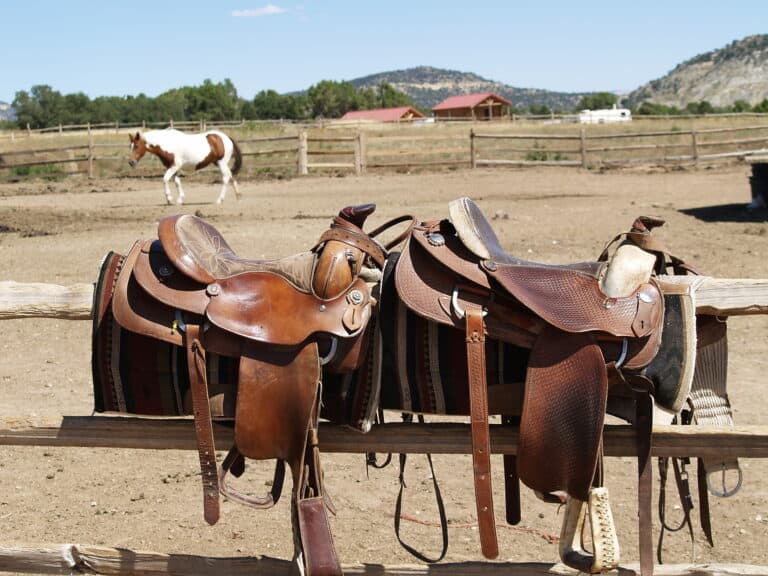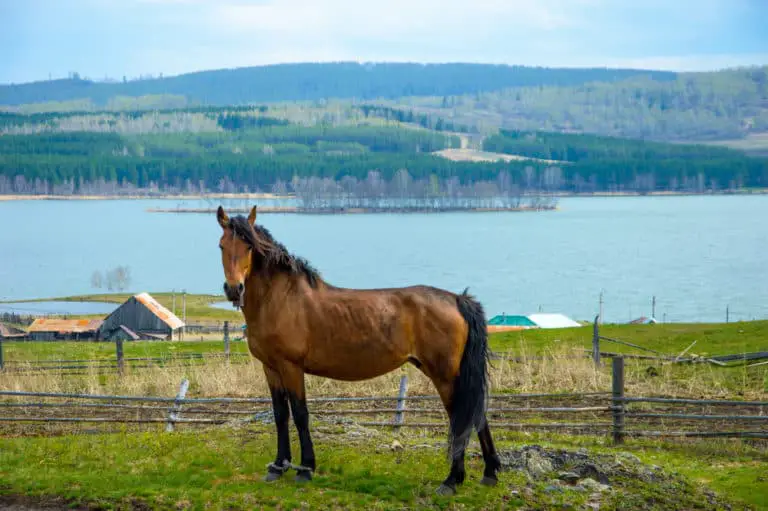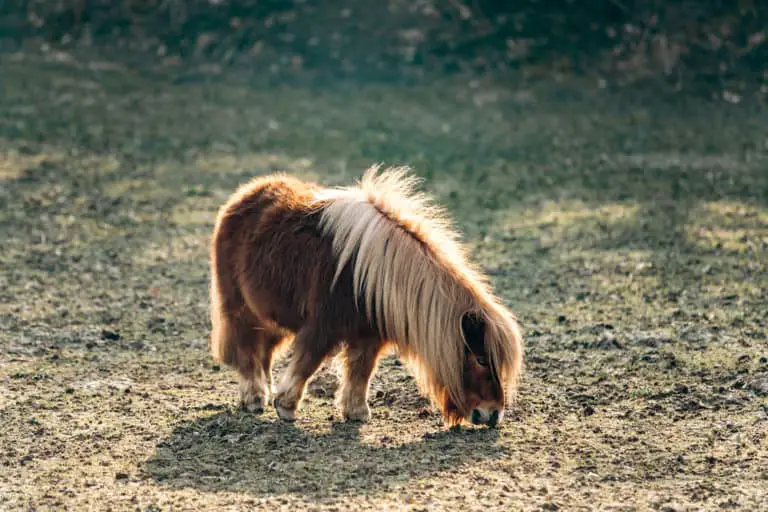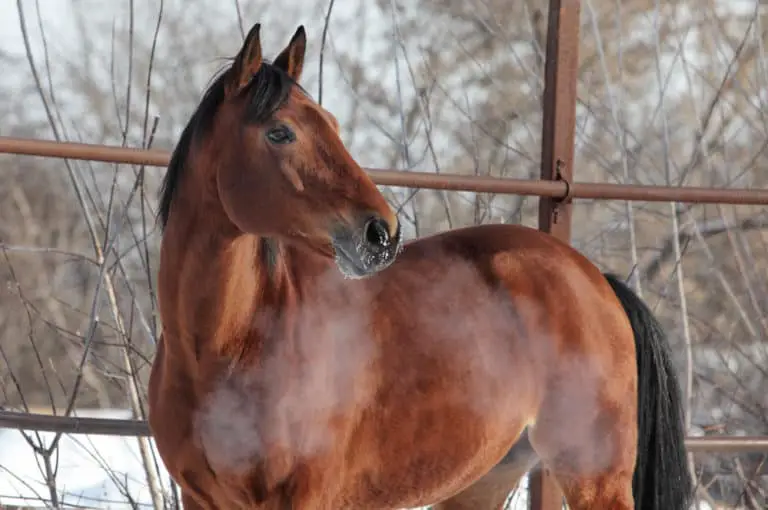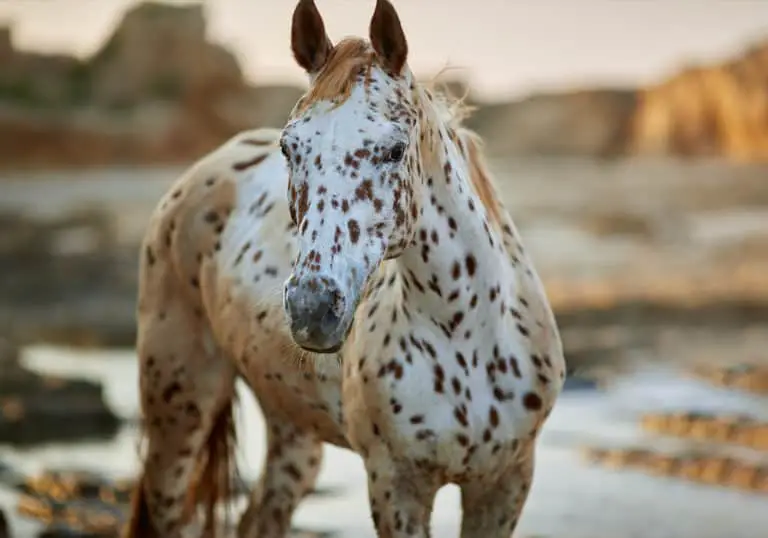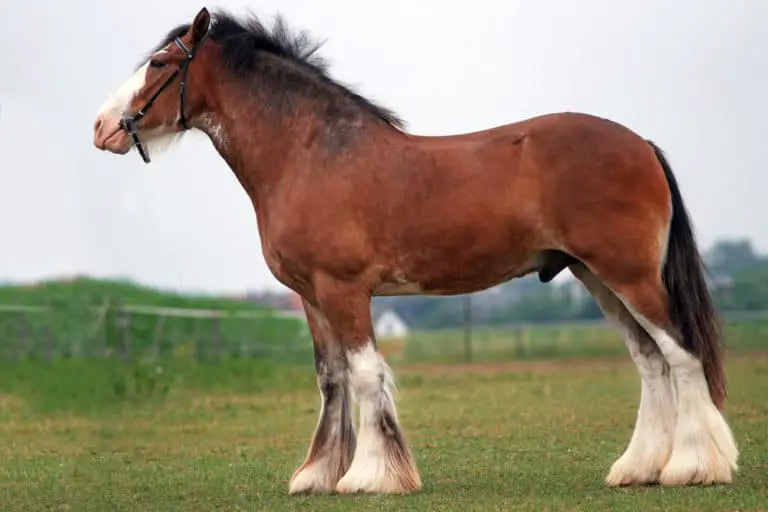Camargue Horse Breed: Care, Cost & History (2024)
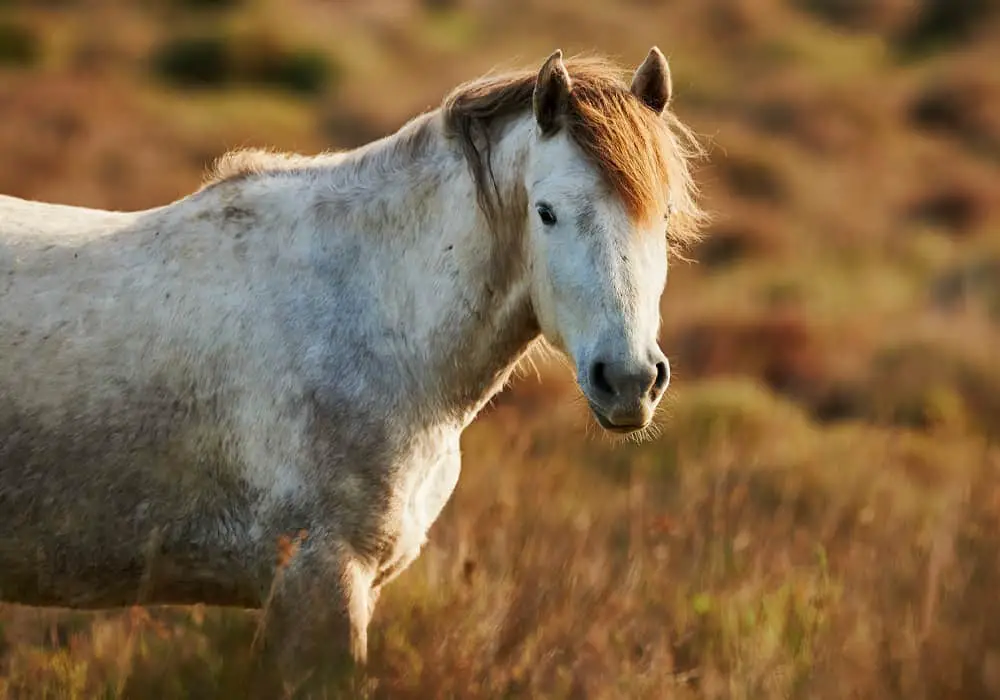
The Camargue horse is a semi-wild breed that has roamed the salt marshes and plains of the Rhône River delta for over a thousand years.
Gardians care for the horses and ride them while tending their semi-wild Camargue bulls used in bullfighting. The iconic gray horses gallop through the sand and sea, delighting all that see them.
Breed: Camargue horse
Adult Weight: 770-1,100 pounds
Adult Height: 13-14 hands (52-56 inches)
Origin: France
Use: semi-wild horses, used for tending Camargue bulls and riding
Colors: Gray, also referred to as white horses
Features: Square heads, stocky legs, muscular body
Lifespan: 20-25 years
Character: Lively, intelligent, and level-headed
Gait: Excellent riding with incredible endurance
Best for: All levels of riders, especially children and small adults
- Characteristics
- Care
- History
- Modern Camargue Horse
- Cost and Ownership
- Buying a Camargue Horse
- Similar Breeds
Camargue Horse Characteristics
Camargue horse characteristics are still primitive. They maintained their square Camargue horse head, squat, muscular stature, broad hooves, and thick manes and tails.
Horses were outcrossed generations ago with military horses in the area, and this resulted in breed improvements.
Natural selection has also continuously improved the wild horses of Camargue, making them an athletic and hardy breed.
Size
Camargue horses are still a relatively small breed, given their semi-wild existence in the Rhône delta.
They average between 13 and 14 hands, so technically, they are large ponies. (1) Camargue horse height is on the small side because of the limited nutrition of their salt marsh diets.
Stallions are slightly larger than mares, and the young horses are born small and slowly grow to their mature height.
Management and subsequent gelding of the stallions by the Biological Research Station of la Tour du Valat further limits their size. Camargue size does not limit the horses’ usefulness; they are stocky and strong.
Weight
Camargue horse weight is between 770 and 1,100 pounds for an adult horse, depending on their height and bone structure. These are rugged, stocky horses given that they are only 13-14 hands.
Generally, the Camargue horse foals are proportionate in size to their sire and dam, steadily gaining weight until reaching full maturity. The Camargue stallion is usually heavier than the mare.
They do have a big bone structure that makes Camargue horse size a non-issue, as they are easily able to carry riders. The weight of the horse is supported by large, broad hooves that developed to efficiently carry the horses through the salt marshes.
Colors
The Camargue breed is born black or brown and then lightens with age, turning gray by age four. They are known as the white horses of Camargue because of their uniform color, matching the clouds and creating a stunning image in their native home.
Although they are called white, the famous Camargue horses are not technically white, as is evidenced by their dark eyes. In fact, the grayness of Camargue colors can be used to help indicate the age of a horse.
Younger horses will appear darker with dapples on their coat, while older horses are milky white or gray, matching the puffy clouds in the sky.
Temperament
The Camargue horse temperament is level-headed and tractable. Not much phases these horses and Camargue horse behavior is a “been there, done that” attitude. But, they are also brave and lively. Years of caring for themselves have made them intelligent.
The Gardians, or Camargue Cowboys, use them as riding horses to tend the Camargue bulls, and gentling and training them is not a huge undertaking.
They also compete in dressage and endurance, among other disciplines. The Camargue breed of horse is not specifically included in the United States Equestrian Federation rules, therefore, the general rules are used and children are not allowed to exhibit stallions. (2)
Camargue Horse Care
The Camargue horse breed is used to caring for themselves, therefore, they are a fairly easy breed for people to own and keep. The horses are hardy, sure-footed, and healthy.
They are intelligent and kind, making them a joy to have around, and do not require any special diet or nutrition.
Diet and Nutrition
These French wild horses subsisted for thousands of years on a limited diet and nutrition. Some people refer to them as the “horse of the sea” because they thrive in saltwater conditions.
Their lifestyle is protected and relatively unchanged. They eat the reeds and samphire, a native French plant, in the spring (1). Their winter diet consists of dried grass and goosefoot, a plant that is too tough for most other herbivores (1).
Grazing regularity depends on the amount of food available. If there is enough food, they only graze at dawn and dusk. Food scarcity prompts them to graze up to 22 hours per day. (1)
Health Problems
There are very few genetic problems among the Camargue breed. Natural selection controlled the breed for many years. Now, the Camargue Cowboys select which stallions will be out with the mares and are allowed to pass on their genetics. (3)
The Camargue breeder has a limited role in the life of these semi-wild horses, and this is perhaps why there are so few health problems among the horses.
Moreover, the horses do not require shelter and are comfortable in extreme heat or incredibly cold weather. (1) Their habitat and lifestyle are protected. Horses that receive rich diets could develop health problems and should be kept similar to their natural state.
Grooming
The Camargue horses provide much of their own grooming within their small herds. However, the Gardians do groom these semi-wild horses when they are handled and ridden.
They are first handled as yearlings when they are separated from their dam and branded. Training begins at age three, and one of the first things the young horse learns is how to be groomed, as the Gardian is building trust.
Camargue grooming occurs regularly as they are ridden and used tending the Camargue bulls. Hooves are broad, an evolutionary development that helps them thrive in the wetlands. They should be cleaned when the horse is groomed.
Camargue Horse History
The Camargue wild horses have inhabited the salty marshes and plains along the Mediterranean coast in south France for thousands of years. Domesticated horses are used in light farm work and for riding.
The breed organization was formed in 1978 to maintain Camargue horse information, and domestically bred horses must adhere to strict guidelines.
Origin
Camargue horse origin is unclear, but it is thought that they descend from the Solutré horse that lived 17,000 years ago. (4) These were prehistoric horses in France.
We know that the Camargue has thrived in the region for thousands of years and is one of the oldest horse breeds. They have existed in relative isolation and fairly undisturbed by humans, other than their Gardians.
The beautiful Camargue horse was naturally selected and has remained genetically close to prehistoric horses and remarkably consistent as a breed.
Outside bloodlines were introduced through military horses and strengthened and improved the breed while preserving their main characteristics.
Historic Development
Camargue horses history is intricately tied to that of the region, and they are protected by the Biological Research Station of la Tour du Valat within the Camargue Natural Park.
The Solutré horse lived in southern France over 17,000 years ago, and the Camargue descends from that horse, and still maintains prehistoric genetics.
The horses have continued breeding and thriving in the wet environment, adapting to survive the dramatic climate swings and limited grazing.
One of the reasons the breed still exists is because they are used by the Gardians or Camargue Cowboys, to tend the Camargue bulls that are also semi-wild in the area.
Notable Camargue Horses
The Camargue horses attract thousands of tourists to the southern region of France every year to see them in the wild, photograph them, and ride them. Many equestrians want to visit and ride the horses, and non-equestrians are intrigued by the thought of riding Camargue horse. Several tour operators offer to ride and viewing excursions.
The Camargue Breed
Unfortunately for most of the horses, they are better known collectively as a breed than as individuals. The Camargue breed is a rare breed, and as such, many riders that use them in dressage, endurance, or other sports are referred to as riding a Camagrue horse. Similarly, even among the Gardians, the horses are referred to collectively.
Coquin, Cambeto, Courneillo and Cantarello
The horses of Valley Farm in the United Kingdom were imported from France in 1992 and helped establish the British breed association and bring greater recognition to their unique qualities. Sarah Robertson owns and manages Valley Farm and thought that the horses would do well in the marshy area she lives in.
Fabriqué en Angleterre
Fabriqué en Angleterre was the first Camargue horse born in the United Kingdom; Cantarello was his mother, and Coquin his father. Fabriqué en Angleterre was born on February 13, 1993, and the breeding program continues at Valley Farm. Camargue horses are used in the riding school at Valley Farm and are popular in the western riding and driving programs.
Myths and Legends
The oldest horse breed in the world with a one thousand year history is bound to have a few myths and legends. The very nature of Camargue existence lends itself to mythology. Many of the myths are founded in facts but deviate slightly from the truth to become a legend instead.
A Gift From Neptune
Since the horses’ origin is mysterious, and the Camargue horses breeding was largely self-directed for thousands of years, a legend about their history developed. It is said that they were a gift from Neptune (also known as Poseidon) to the people. The horse was to be their companion. Neptune is the God of horses, earthquakes, the sea, and waters.
Riding With A Trident
Neptune gifted the Camargue horse to humans because he found a man in the sea who was chased by a black Camargue bull. Neptune gave the man the horse so he could escape. The man was still nervous and grabbed a branch with three prongs like the trident Neptune carried. Gardians still ride with tridents today.
Lou Drapé
The legend states that Lou Drapé, a horse in the Camargue region, wanders through the towns at night and carries the children away on its back. The legend states that the children are never seen again. Although the Camargue horse is not specifically mentioned in the legend, the horse is gray in every retelling of the story.
Modern Camargue Horses
The Camargue grows more popular every year. Social media and the Internet made them famous with photos of them galloping through the water or in another picturesque scene.
Their close ties to the Gardians and their lifestyle protected the breed, and now their level-headed and lively spirit makes them popular horses for a variety of riding disciplines.
Breeding
Naturally, most of the Camargue horse population is found in France. However, there is a Camargue breeding society in the United Kingdom and horses were also imported to Italy (5). The Camargue horse pedigree is primarily restricted to within their manade, or small herd, tended by the Gardian. Breeding is at liberty within the manade.
Population
The Camargue population is believed to be around 2,000 horses. The vast majority, probably 90% are in France. There are over 150 registered Camargue horses in Italy now. The limited total population size makes it challenging to increase population numbers outside of France without threatening genetic diversity and characteristics like Camargue height.
Uses
Camargue horse uses include their work with the Gardians tending the Camargue bulls, as well as riding.
They are popular in endurance because of their tractable Camargue gait, ability to withstand any weather condition and go long distances without food. The horses are successful in other disciplines as well, including western, driving, jumping, polocrosse, trail riding, and as lesson horses.
If a stallion isn’t selected for breeding, he will become a Camargue gelding and be used as a saddle horse. The breed is fairly versatile because of its intelligence and lively spirit. They are also popular with children and petite adults because of their size.
Camargue Horse Prices
The Camargue horse price can be higher than other horses because they are not as widely available.
It is easier to find a horse within France, and now there are more available in Europe, but they are still relatively scarce. The cost of keeping a horse fed and boarded must also be considered in the Camargue price.
Purchase Price
The purchase price is dictated by supply and demand, and it is no different for the Camargue horse. Their mythical qualities and fame influence the price, and they are considered expensive horses to purchase.
The breed population is smaller than others, therefore not as many horses are available. Those that are sold were usually purchased from the Camargue Cowboys and used as riding horses or in the region’s tourism industry.
Prices range from $5,000 to $15,000 in U.S. Dollars for an adult horse that is fully trained and rideable. Foals are generally not sold as the Gardians haven’t determined which they want to keep in their herds.
Ownership Costs
Owning a horse involves so much more than the original purchase price. Calculations must include boarding and feeding the horse, as well as veterinary and hoof care.
Location and level of services influence the price, but owners should budget between $1,770 and $12,930 per year for essential horse ownership costs. (6)
Board
Horses must have a place to live; boarding usually consists of a stall and turnout in a paddock or pasture. The Camargue lives naturally with no shelter on its own, so rough board in a field with a run-in shed is acceptable. Costs vary between $1,200 and $7,200 annually depending on location and amenities. (6)
Feed
Horses must be fed daily, and their diet needs to mimic continuous grazing as much as possible to avoid health disorders. The cost ranges from $250 to $4,380 per year, depending on the type of feed and grazing available. Camargue horses will do best with grass in their diet based on their natural lifestyle. (6)
Vet Care
Routine veterinary care is imperative for horses. Like a trip to a human doctor, prevention is the best medicine. Horses need annual vaccinations, deworming, dental care, and health checks. The average cost is between $200 and $350 annually, however, if a horse gets hurt or sick there will be additional costs. (6)
Hoof Care
Horse hooves grow continuously and need to be trimmed regularly to keep the horse healthy and sound. Camargue horses do not need shoes, thanks to their evolutionary developments, but still require trims. Their feet developed for wet conditions so may need special care outside their natural environment. The average cost per year is between $120 and $1,000. (6)
Buying a Camargue Horse
Watching Camargue horses thunder down the beach can prompt anyone to purchase a magical French horse. Their scarcity adds to the allure, but don’t buy the first one you see available.
Each horse still has a unique personality and it’s important to meet the horse and understand the living conditions it will thrive in before you buy one.
Is the Camargue Horse Right for You?
The Camargue horses are semi-wild, however, some are domesticated and sold by the Gardians. Equestrians are thrilled by the opportunity to own one of these magical horses, and the domesticated horses are popular.
Camargue is rugged and hardy; able to survive extreme conditions with minimal care. Although the horses enjoy their new lifestyle with owners, it’s best to keep their living conditions as natural as possible.
The Camargue is a good breed for children and small adults, given their height. Although they can carry heavier riders, a tall person can look out of place on a Camargue. Horses are suited to work cattle, endurance, trail, dressage, and other disciplines.
How to Buy a Camargue Horse?
Buying a Camargue horse is easiest for those in southern France, where the majority of the population is. Horses are in their manades, the Gardians’ small herds.
It’s important to look for a horse that is trained and has lived the Camargue horse lifestyle, as these will be the healthiest and hardiest.
Purchasing a Camargue horse from their second owner is a likely scenario, and it’s important to understand how the horse was cared for and if this influenced their health or behavior at all.
Horses fed rich diets or continuously kept in stalls may not be as physically or mentally healthy as their counterparts.
Similar Breeds to Camargue
The Camargue is a legendary breed unique to themselves because of its long history and lifestyle.
However, it is possible to find some similar breeds.
The Barb and Mustang breeds are also known for their hardiness and stamina, while the Chincoteague Pony exists and thrives in a similar salt marsh and wet environment.
Barb
Barb horses originate from North Africa and were bred as riding horses used in this challenging climate. They are similar but distinct from Arabians.
Horses are extremely hardy with the incredible endurance needed to carry riders through the desert environment. The population is small because of economic challenges in the region.
Mustang
The American Mustang is a smaller horse like the Camargue, and lives in wild conditions in the western part of the United States.
These horses are considered feral, and when domesticated are wonderful riding horses with the same intelligence, endurance, and sure-footed abilities shown by the Camargue horse. They descend from Spanish horses and were crossed with other breeds.
Chincoteague Pony
Chincoteague ponies live on Assateague Island, a barrier island facing the Atlantic Ocean in the United States.
It is thought that they survived a Spanish galleon shipwreck and have been feral on the island since then. They are shorter than Camargue horses – 12 to 13 hands – but survive on a similar diet in a wet environment.
FAQ
What is a Camargue horse?
A Camargue horse is a semi-wild breed that developed in France and lives in the salt marsh plains of the Rhône delta.
What does a Camargue horse look like?
Camargue horse colors are gray, often called white. Horses have short legs, a stocky build, and square heads with long manes and tails.
How did the Camargue horse get its name?
The Camargue horse is named after the region in southern France where the breed originated.
Can you ride a Camargue horse?
Yes, Camargue horses can be ridden and are used by the Gardians, also known as Camargue Cowboys, as well as in endurance and dressage.
Are Camargue horses good for beginners?
Trained Camargue horses are good for beginners because they are intelligent, tractable, and have a smaller stature. Beginners should not have untrained horses.
How tall is a Camargue horse?
The Camargue horse is 13 to 14 hands tall, or 52 to 56 inches high.
How much does a Camargue horse weigh?
The Camargue horse weighs between 770 and 1,100 pounds at maturity.
How big is a Camargue horse?
The Camargue horse is 13 to 14 hands and stocky, weighing between 770 and 1,100 pounds, so they are a very stocky horse.
How much does a Camargue horse cost?
Camargue horses are more expensive than other breeds because they are scarce. The purchase price is between $5,000 and $15,000.
How much does a Camargue horse ownership cost?
Owning a Camargue horse can cost between $1,770 and $12,930 per year.
How long do Camargue horses live?
The Camargue horse’s lifespan is between 20 and 25 years.
How fast can a Camargue horse run?
Camargue horse speed is between 25 and 30 miles per hour, with some faster and slower.
How much can a Camargue horse pull?
A Camargue horse can pull between 1,155 and 1,650 pounds, depending on its size.
How much can a Camargue horse carry?
Camargue horses can carry up to 220 pounds.
At what age is a Camargue horse full grown?
The Camargue horse matures slowly and is completely mature between ages five and seven.
What are Camargue horses used for?
Domesticated horses are used by cowboys tending bullfighting animals, and in dressage and endurance, among other disciplines. Some remain wild in Camargue Regional Park.
References
- The Languedoc-Roussillon. 2022. Camargue Horses. Link
- U.S. Equestrian Foundation. 2022. Conduct of licensed competitions. Link
- Oklahoma State University, Department of Animal Science. 2022. Breeds of Livestock – Camargue Horses. Link
- Avignon et Provence, 2022. The Camargue Horse. Link
- Fédération Équestre Internationale, Patricia Salem. 2022. Breed Profile: The Camargue Horse. Link
- Arabian Horse Association, 2022. What is the Cost of Providing for Them? Link

